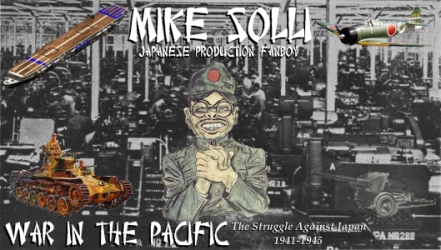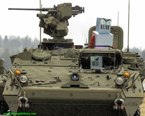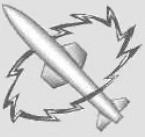HistoryGuy
Posts: 80
Joined: 1/7/2009
From: Woodbridge, VA
Status: offline

|
Hi, I am new to the forum (just checked it out once in a while to see when the Admirals Edition comes out) but I have been awed by Harald's research on the KNIL. Looking at the USAFFE units a few days ago, I decided to collect a little information to perhaps help out with the Philippines land OOB. Please forgive me if you have already gotten this for the AE version. If anything, perhaps the names of real commanders can be added to the Filipino and US leaders list......
Philippine Army OOB 1941
I think that the US forces in the Philippines should be represented as accurately as KNIL formations in the Dutch East Indies. The Wikipedia entry on Battle of the Philippines 1941 42 is fairly accurate, but there are some omissions.
Theoretical Philippine Army Infantry Division MTOE total strength 8600 officers and men. Three x 1400 strong infantry regiments. One x 1260 strong artillery regiment. Engineer, anti-tank, and medical battalions with 5-600 personnel. Also signal, transportation, supply and quartermaster companies.
PA artillery regiments were theoretically organized with a 175 man HHB, one 2.95-inch mountain howitzer battalion with 375 personnel, and two 75-mm M1917 gun battalions (British manufactured weapons of World War One vintage) with 375 officers and men. Most artillery battalions had three 4-gun batteries.
Note on artillery pieces - When United States joined World War 1 in 1917, the field artillery weapons used by the small Army it had, were almost all outdated. Only somewhat modern field artillery piece in its disposal was US designed 4.7-inch field cannon M1906. To equip their expanding artillery force, American military commanders decided to acquire large number of new field artillery, which were either manufactured abroad or were foreign designs, which US industry started manufacturing. One of these foreign designs manufactured in the US was "75 mm Field Gun M1917 (British)", which essentially was British 84-mm "Ord. QF 18-pdr Gun Mark I" field gun modified to use same ammunition as the French 75-mm "Materiel de 75, Modele 1897" field gun. This combination offered US troops fighting in Europe readily available, reliable and proven gun design with ammunition easily available in large amounts from local sources. The gun had pole trail, recoil system on top of the barrel, gun shield (whose upper and lower parts could both be folded), screw breech and wheel anchors (used to remove last of the recoil). The sight used was dial sight. Unfortunately the chosen design didn't include the latest British improvements, so the recoil system still had hydro/spring buffer/recuperator system. US manufacturers (from which Bethlehem Steel was the largest) made about 1,000 guns, which remained in US arsenals after WW1 ended. The United States sent a number of these guns during the 1930s to the Philippines at no cost beyond shipping.
The QF 2.95 inch mountain gun was the designation given by the British to a Vickers 75mm gun. It was originally produced for the Egyptian Army. It was taken into British service in the late 19th Century to provide the 'movable armament' at some coaling stations. Also known as 'The Millimetre Gun', it was used by the West African Frontier Force in several theatres in Africa during World War I. The US originally purchased 12 of these guns in 1899 and used them in the Philippine-American War. By 30 June 1904 another 120 guns were purchased. Carriages and pack saddles were manufactured at Watertown and Rock Island. That figure would have allowed the US to theoretically equip ten Philippine artillery battalions.
That said, three PA Infantry Divisions (61st, 81st, and 101st ?) had to convert their artillery regiments to infantry when they did not receive their full complements of cannon before entering combat.
Mobilized strength of the Philippine Army on 31 October 1941 4,128 Officers and 29,318 Enlisted men
I Philippine Corps/North Luzon Force: Maj. Gen. Jonathan M. Wainwright
I Corps/North Luzon Force Engineer: Col. Harry A. Skerry
I Corps Strength report for 7 February 1942: 472 US officers, 1712 US Enlisted, 4721 Philippine Scouts, 1601 Philippine Army Officers, 22094 Philippine Army enlisted, 1169 civilians
South Luzon Force: Brig. Gen. Albert M. Jones
II Philippine Army Corps/Bataan Defense Force: Maj. Gen. George M. Parker (a notch or two above Lloyd Fredendall)
Corps Troops:
201st Engineer Battalion Maj. Harry O. Fisher (340 PA personnel with Philippine Constabulary NCOs)
202d Engineer Battalion Capt. Major Mitchell (250 personnel)
II Corps Strength report for 7 February 1942: 429 US officers, 1451 US enlisted, 2086 Philippine Scouts, 1713 Philippine Army officers, 24191 Philippine Army enlisted, 896 civilians
Division strengths on 31 October 1941 (source Rpt, Commonwealth of the Philippines, Army headquarters, Manila, Office G-1 Division, dtd 21 Nov 41)
11th Division 334 officers and 2514 enlisted men
21st Division 407 officers and 2774 enlisted men
31st Division 382 officers and 2629 enlisted men
41st Division 405 officers and 2891 enlisted men
51st Division 373 officers and 2831 enlisted men
61st Division 397 officers and 2625 enlisted men
71st Division 395 officers and 2705 enlisted men
81st Division 387 officers and 2379 enlisted men
91st Division 287 officers and 2681 enlisted men
101st Division 303 officers and 2000 enlisted men
Other inducted units 458 officers and 32819 enlisted men (note: PA still in mobilization process at this date)
1st Philippine Army (Regular) Infantry Division Brig. Gen. Fidel V. Segundo
1st Infantry Regiment Col. Kearie L. Berry
Senior US Instructor Maj. Ralph E. Rumbold
2d Infantry Regiment (remained on Mindanao due to lack of shipping) Col. Calixto Duque
3d Infantry Regiment Col. Albert H. Dumas
1st Artillery Regiment Not activated
1st Engineer Battalion
Note 1: Do not let the designation Regular fool you. This division was formed in December 1941 from officer cadets, retired Philippine scouts, and odds and ends.
Note 2: 2d Regiments strength in March 1942 was 800 officers and men.
Note 3: In April 1942 the divisional strength included 225 officers and 4300 enlisted men.
2d Philippine Army (Regular) Infantry Division (PC) Brig. Gen. Guillermo B. Francisco
2d Division US Senior Instructor Col. Edwin OConnor
1st Philippine Constabulary (PC) Regiment Brig. Gen. Simeon de Jesus?
US Senior Instructor Lt. Col. Irvin Alexander
2d Philippine Constabulary Regiment
1-2 Constabulary
2-2 Constabulary Maj. Diogracias U. Tenasas
4th Philippine Constabulary Regiment
Note 1: As of Apr 42 the 2d Division consisted of 325 officers and 5700 enlisted men. The 1sr Regiment had been inducted into USAFFE on 15 October 1941, followed by the 2d and 3d Regiments on 17 November and 12 December 1941 respectively. The 4th PC Regiment was mobilized on 29 December 1941.
Commanding General, 11th (Reserve) Infantry Division Brig. Gen. William E. Brougher
Chief of Staff Col. Moran
Division Signal Officer Lt. Col. Blackburn
11th Infantry Regiment Col. Glen R. Townsend (moderate competence)
11th Regiment Executive Officer Maj. Russell W. Volckmann
1/11 Infantry
2/11 Infantry Maj. Helmert J. Duisterhof (awarded DSC came from 57th Infantry)
3/11 Infantry Capt. Antonio Alejandro
12th Infantry Regiment
1/12 Infantry
2/12 Infantry
3/12 Infantry Maj. Moses (moderate competence)
13th Infantry Regiment Col. Green (?) (not very good commander)
1/13 Infantry Maj. Noble (moderate competence)
2/13 Infantry
3/13 Infantry
11th Field Artillery Regiment Col. James C. Hughes
11th Engineer Battalion Capt. Amado N. Bautista
Note 1: 13th Infantry Regiment disbanded early in the Philippine campaign to provide replacements for 11th and 12th Regiments.
Note 2: Amado Bautista Diary, dtd 4 Feb 46, states: On 7 December, the 11th Division headquarters was being organized at Manaoag, Pangasinan. The 11th Division sector was as follows: From Calmay River exclusive, Dagupan and Calasiao inclusive, Malasiqui exclusive, Alcala inclusive, extending northward along Union Shores and Ilocos Coast and with an outpost of one infantry battalion at Tuguegarao, Cagayan. The main strength was concentrated at Pangasinan. The 11th Engineer Battalion, mobilized and fully activated about two months before, was in division reserve at Camp Carayungan, less Company C at Manaoag. [Engineer] Units in full strength, almost completely equipped organically, but with only five rounds of ammunition per man borrowed from the Constabulary Company at Tuyag.
Commanding General, 21st (Reserve) Infantry Division Brig. Gen. Mateo M. Capinpin
Senior American Instructor Colonel Ray M. ODay
21st Infantry Regiment Lt. Col. Valentin Valasco
21st PA Regiment US Senior Instructor Col. William A. Wapperstein
1/21 Infantry Maj. Robert Besson
2/21 Infantry Capt. Philip A. Meier
3/21 Infantry Capt. Robert Pennell
22d Infantry Major Joaquin D. Esperitu
22d Infantry US Senior Instructor Col. Jacob E. Uhrig
23d Infantry Major Liberato Littaua
US Senior Instructor Col. Wallace A. Mead
3/23 Capt. H.E. Wandell
21st Artillery Regiment Lt. Col. Nemisio Catalan (three battalions of 75-mm cannon vice 2 battalions of 75-mm and one battalion of 2.95-inch mountain howitzers) 1/21 FA Lieutenant Valdez, 2/21 FA Lieutenant Mercado, 3/21 FA Lieutenant Acosta.
21st FA Senior US Instructor Col. Richard C. Mallonee
21st Engineer Battalion Capt. Atilano F. Montesa (KIA)/Capt. Louis Bartholomees
Note 1: The 21st Infantry Division acquired six modern 81-mm mortars from the Field Artillery School at Camp Del Pilar.
Commanding General, 31st (Reserve) Infantry Division Brig. Gen. Clifford Bluemel
Chief of Staff Col. Pastor Martelino
G-1 Lt. Col. Jose Andrada
G-2 Maj. Salvador T. Villa (very inspirational and enthusiastic)
G-3 Maj. Pedro Deang
G-4 Maj. Napoleon D. Valleriano (graduate of US Army Cavalry School in 1939)
31st Infantry Regiment Col. John W. Irwin
1/31 Infantry
2/31 Infantry Lt. Col. Cyril Q. Marron
3/31 Infantry
32d Infantry Regiment Col. Edwin H. Johnson
33d Infantry Regiment Major Stanley Holmes
1/33 Infantry Maj. Howard C. Crawford
2/33 Infantry Capt. Lloyd M. Buchel
3/33 Infantry Capt. Robert M. Chapin
31st Artillery Regiment
Note 1: On the average, there was only a single Browning Automatic Rifle in each infantry company, only eight 30-caliber water cooled machineguns in each heavy weapons company, and two 50-caliber machineguns for each regiment. There were no modern 81-mm mortars, only the 3-inch Stokes mortar of WW1 vintage. It was estimated that the 3-inch mortars had a seventy percent dud rate. Ammunition for the divisions 60-mm mortars was never delivered.
Note 2: The 31st Field Artillery Regiment did not finish organizing until 26 December 1941 and possessed only two 75-mm gun batteries.
Commanding General, 41st (Reserve) Infantry Division Brig. Gen. Vicente Lim (moderate competence)
Senior American Instructor Colonel Malcolm V. Fortier (moderate competence)
41st Infantry Regiment Lt. Col. Silvino Gallardo
Senior American advisor Col. Loren A. Wetherby
1/41 Infantry Capt. Jacobo Zobel
2/41 Infantry Lt. Constancio de Zosa
3/41 Infantry
42d Infantry Regiment Lt. Col. Claro B. Lizardo
Senior American advisor Col. Edward C. Atkinson
1/42 Infantry
2/42 Infantry
3/42 Infantry
43d Infantry Regiment Col. Valentin Salgado
Senior American advisor Lt. Col Eugene T. Lewis
1/43
2/43 Lt. N. L. Matthews
3/43
41st Artillery Regiment Lt. Col. Arthur P. Moore
41st Engineer Battalion Capt. Rigoberto Atienza
Note 1: The divisions regiments had received the following amount of post-mobilization training: 41st (five weeks), 42d (thirteen weeks), and 43d (none).
Note 2: Three BARs issued to each rifle company. The only anti-tank armament in the division consisted of 50-caliber water cooled machineguns (M12?) that none of the American advisors were familiar with them. The division had its full complement of sixteen 75-mm cannon and eight 2.95-inch mountain howitzers.
Commanding General, 51st (Reserve) Infantry Division Brig. Gen. Albert M. Jones
Chief of Staff Col. Stuart C. MacDonald/Col. Edwin E. Aldridge
51st Infantry Regiment Lt. Col. Loren P. Stewart
52d Infantry Regiment Colonel Virgil N. Cordero (two battalions)
53d Infantry Regiment Col. John R. Boatwright
51st Field Artillery Regiment Col. Hamilton R. Searight
Note 1: The FA regiment only possessed two batteries of 75-mm cannon.
Commanding General, 61st (Reserve) Infantry Division Brig. Gen. B.G. Chenowyth (he replaced Brig. Gen. Walter F. Sharp)
Chief of Staff Col. John W. Thompson (replaced by Col. Irvin C. Scudder when Brig. Gen. Chenowyth arrived before Scudder was himself replaced by Col. Roger Hilsman)
G-1 Lt. Col. Jose Consaise
G-2 Lt. Col. Cruse
G-3 Maj. Jordan
G-4 Capt. English
61st Infantry Regiment Col. Eugene H. Mitchell
62d Infantry Regiment Lt. Col. Allen Thayer
63d Infantry Regiment Col. Albert F. Christie
64th Infantry Regiment (PA) (Provisional)
65th Infantry Regiment (PA) (Provisional)
61st Artillery Regiment Col. Hiram W. Tarkington
One battery with three 2.95-inch mountain howitzers?? (per memorandum for record by Lt. Eugene E. Greeson, Subj: The Visayan-Mindanao Force, dtd 30 Jan 45, filed at CMH)
Cebu Military Police Regiment Lt. Col. Howard J. Edmunds (ultimately consisting of eleven companies [one regimental HHC, two battalions with eight rifle and two heavy weapons companies] with strength ranging from 114 to 89 personnel. They possessed Enfield Rifles and four Browning Water-cooled MMGs per company the weapons were requisitioned from the four college ROTC detachments on Cebu). Heavy Weapons Companies: Company D had eight 30-caliber water cooled, one .50-caliber machinegun and two Stokes mortars. Company H (formed from a cadre from Company D (heavy weapons) possessed three water cooled and five air cooled .30-caliber machineguns (the latter were salvaged from a crashed P-40 Warhawk).
Commanding General, 71st (Reserve) Infantry Division Brig. Gen. Clyde A. Selleck (later relieved by 26th Cavalry Regiment commander)
71st Infantry Regiment Lt. Col. Donald Van N. Bonnett
72d Infantry Regiment Lt. Col. Irwin Compton
73d Infantry Regiment (remained on Mindinao due to lack of shipping) Lt. Col. Robert H. Vesey
71st Artillery Regiment Lt. Col. Halstead C. Fowler
Commanding General, 81st (Reserve) Infantry Division Brig. Gen. Guy S. Fort
81st Infantry Regiment
82d Infantry Regiment Lt. Col. David
1/82d Infantry Capt. Mammon Sharp
2/82d Infantry
3/82d Infantry
83d Infantry Regiment Maj. William Rogers
Senior US Instructor Lt. Col. Marcus Boulware (later sent to 61st Division as G-4)
1/83d Infantry Maj. William McClanahan (replaced by Capt. Lyle Hardin)
2/83d Infantry Capt. Sharp
3/83d Infantry Lt. Col. Arthur J. Grimes
84th Infantry Regiment (Provisional)
81st Artillery Regiment Lt. Col. John P. Woodbridge
3d Philippine Constabulary Regiment
Note 1: The Visayan Mindanao Force (commanded by Col. Ben-Hur Chastaine) consisted of 3rd Infantry Regiment (Philippine Constabulary), 81st Infantry Regiment (Philippine Army), Co. A, 81st Medical Battalion, Agusan Provisional Battalion (PA), Agusan Constabulary Battalion, Surigao Provisional Battalion (PA & PC) and Headquarters (Provisional) Agusan Sector (PA). The PC Regiment was responsible for defending Cagayan and the PA regmient (-) responsible for Davao. The 3/81 Infantry (Capt. J.O. Stensland) and Agusan Provisional Battalion defended Butuan Bay. The Surigao Provisional Battalion defended the Surigao Peninsula. The Agusan Constabulary Battalion controlled the movement of the civilian population and conducted rear area security. Source: Operations Order, USAFFE, Hqs Agusan Sector, Gingoog, Misamis, SUBJ: War Plans Agusan Sector, dtd 27 Feb 42. Original at CMH.
Note 3 The 81st Artillery Regiment had at least one section of 2.95-inch mountain howitzers.
Commanding General, 91st (Reserve) Infantry Division Brig. Gen. Luther R. Stevens
91st Infantry Regiment
92d Infantry Regiment Col. John H. Rodman
92d Infantry Executive Officer Col. James D. Carter
93d Infantry Regiment (remained on Mindanao due to lack of shipping) Maj. John C. Goldtrap
91st Artillery Regiment
91st Engineer Battalion Capt. Antonio P. Chanco
C & E Companies, 43d Infantry (PS) Maj. Allen L. Peck (reactivated and organized with soldiers from the 45th Infantry (PS) on detached duty in Zamboanga).
Note: Artillery consisted of two batteries with eight portee 2.95-inch mountain howitzers.
Commanding General, 101st (Reserve) Infantry Division Brig. Gen. Joseph P. Vachon
101st Infantry Regiment Col. Russell J. Nelson
1/101 Infantry
2/101 Infantry Lt. Col. Roger B. Hilsman
3/101 Infantry Lt. Col. Howard N. Frissell
102d Infantry Regiment Col. William P. Morse (?)
103d Infantry Regiment Maj. Joseph R. Webb (apparently a very competent officer)
104th Infantry Regiment?? Mentioned in Morton Fall of the Philippines on p. 511.
101st Artillery Regiment Lt. Col. Reed Graves?
Note 1: Although some accounts state that no artillery was ever provided to the division, the trio of mountain howitzers listed for the 61st Division may have belonged to the 101st Artillery Regiment.
Note 2: Lt. Greeson writes: For the purpose of defense the island was divided into six sectors. General Vachon commanded the Cotabato-Davao sector; General Fort the Lanao sector; Col. Morse, the Cagayan sector; and Col. Ben-Hur Chastaine, the Agusan sector. The Zamboanga sector was commanded initially by Col. Dalton, but in February 1942 this command was given to Col. Wilson and Col. Dalton assumed command of the Force training school. In February a Zone of the Interior was created with Col. Frissell in command. In the Visayan Islands, General Chynoweth commanded the island of Panay; Col. Hillsman, the Island of Negros; Col. Scudder the island of Cebu; and Major Jones, the islands of Samar and Leyte.
Commanding General, 102d (Reserve) Infantry Division Col. William P. Morse
103d Infantry Regiment (see 101st Division)
61st Artillery Regiment (see 61st Division)
81st Artillery Regiment (see 81st Division)
Note 1: Would be reorganized with the 62d Infantry, 81st Field Artillery, C & E Companies, 43d Infantry (PS) and a 2.95-inch mountain howitzer detachment after its first battle on 3 May 1942.
US FORCES
Strength and composition of US Army Troops in Philippine Islands on 30 November 1941:
Philippine Division 10,233 total (incl 517 officers, 1807 Americans, and 7909 Philippine Scouts)
26th Cavalry 55 officers and 787 enlisted men
43d Infantry Regiment (PS) 328 officers and enlisted men (see 91st PA Division)
31st Infantry (US) 97 officers and 1755 enlisted men
45th Infantry (PS) 108 officers and 2,152 enlisted men
57th Infantry (PS) 105 officers and 2,154 enlisted men
23d FA Regiment (PS) 411 officers and enlisted men
24th FA Regiment (PS) 869 officers and enlisted men
12th MP Company 134 officers and enlisted men
12th QM Regiment 586 officers and enlisted men
12th Medical Regiment 419 officers and enlisted men
12th Ord Company 142 officers and enlisted men
12th Signal Troops 226 officers and enlisted men
14th Engineers 883 officers and enlisted men
4th Vet Company 1 officer and 11 enlisted men
Source: Rpt, Philippine Department, MRU Station, Strength and Misc., officers and enlisted men, November 1941
OTHER US/PS Units
86th FA Regiment (PS) 395 officers and men
88th FA Regiment (PS) 538 officers and men
808th MP Company 160 officers and men
192d Tank Battalion 588 officers and men
194th Tank Battalion 410 officers and men
Source: Rpt, Philippine Department, MRU Station, Strength and Misc., officers and enlisted men, November 1941
Philippine Division
Commanding General: Brig. Gen. Maxon S. Lough
Division Headquarters
Headquarters, Special Troops (PS)
Headquarters Company (PS)
12th Military Police Company (PS)
12th Ordnance Company (PS)
12th Signal Company (PS)
43d Infantry Regiment (PS) (see 91st PA Division)
45th Infantry Regiment (PS) Col. Thomas W. Doyle
45th Infantry Executive Officer Lt. Col. Donald B. Hilton
1/45 Infantry Lt. Col. Leslie T. Lathrop
2/45 Infantry Lt. Col. Ross B. Smith (moderately capable)/Maj. Andrew B. Zwaska
3/45 Infantry Maj. Dudley G. Strickler/Lt. Col. Leslie T. Lathrop
57th Infantry Regiment (PS) Col. George S. Clarke (succumbed to combat fatigue in first battle)
57th Infantry Executive Officer Lt. Col. Edmund J. Lilly (later commanding officer)
1/57th Infantry Maj. Royal Reynolds (above average officer)
2/57th Infantry Lt. Col. Hal C. Granberry (excellent combat leader)
3/57th Infantry Lt. Col. Philip T. Fry/Lt. Col. Harold K. Johnson
24th Field Artillery Regiment
1/24th FA Lt. Col. Charles B. Leinbach
23d Field Artillery Regiment Lt. Col. Hanford R. Lockwood
14th Engineers (PS)
12th Medical Regiment (PS) Col. James W. Duckworth
31st Infantry Regiment Col. Charles L. Steel/Lt. Col Jasper E. Brady (Steel became II Corps Chief of Staff on 2 March 1942)
1st Battalion, 88th Field Artillery (PS)
2d Battalion, 88th Field Artillery (PS)
4th Veterinary Company (PS)
65th Separate Quartermaster Company
66th Separate Quartermaster Company
17th Ordnance Company (Armd)
1/31 Infantry Lt. Col. Edward H. Bowes
2/31 Infantry Maj. Lloyd C. Moffitt
3/31 Infantry Lt. Col. Jasper E. Brady
26th Cavalry Regiment (Philippine Scouts) Col. Clinton A. Pierce/Col. Lee C. Vance (excellent officer)
1/26 Cavalry
2/26 Cavalry Maj. James C. Blanning
Note: The Philippine Division, a mixed US/Filipino formation, was authorized 10,400 officers and men. It consisted of the 31st US Infantry, 45th Infantry (Philippine Scout), and 57th Infantry (PS). The American regiment had 1,800 personnel while the strength of both PS regiments was about 2,100 officers and men. Both the Americans and the scouts carried the new M-1 Garand rifle. Each rifle company had three 60-mm mortars and each battalion heavy weapons company possessed an average of eighteen water cooled 30-caliber machineguns, one or two .50 caliber machineguns, and one or two 81-mm mortars. Divisional artillery consisted of the two-battalion 24th Field Artillery Regiment with truck drawn 75-mm guns and mule packed 2.95-inch mountain howitzers and the one battalion 23d Field Artillery Regiment with a single battery of 2.95-inch mountain howitzers and two batteries of 75-mm guns.
SELECTED NON-DIVISIONAL UNITS
4th Marine Regiment Colonel Howard
86th Field Artillery Regiment (PS) Lt. Col. Winfield Scott (12 155-mm GPF guns)
301st Artillery Regiment Col. Alexander S. Quintard (16 155-mm GPF guns and 2 155-mm howitzers)
Provisional Tank Group Brig. Gen. James R. N. Weaver (moderate competence)
Group Executive Officer Col. Thaddeus E. Smyth (moderate competence)
Equipped with 91 M3 light tanks, fifteen Bren gun carriers, and 42 halftracks.
192d Tank Battalion Lt. Col. Theodore F. Wickord (moderately competent)
194th Tank Battalion Lt. Col. Ernest B. Miller
Note 1: 194th Tank Battalion did not have its Company B (minus seventeen M3 Stuarts)
Provisional Self-Propelled FA Group Fifty self-propelled 75-mm on halftracks. Originally formed with three battalions with four, four gun batteries. (Consolidated into two battalions later)
1st Battalion Capt. Gordon F. Peck
2d Battalion Maj. David S. Babock
3d Battalion Major Joseph Granahl (moderate competence)
200th Coast Artillery (AA) Regiment Col. Charles G. Sage
515th Coast Artillery (AA) Regiment Lt. Col. Harry M. Peck (A Battery Searchlight, B,C, and D Batteries - 3-inch AA guns, E Battery .50 caliber AA machineguns, and F , G, and H batteries 37-mm AA guns). The regiment possessed a total of 12 3-inch AA guns, 23 37-mm. AA guns, and fifteen searchlights.
Air Corps Provisional Regiment Col. Irvin E. Doane (an experienced infantry officer with previous service in the Philippine Scouts)
1st Battalion Capt. Coleman
2d Battalion
Naval Battalion Commander Francis J. Bridget Formed on 9 January 1942. Consisted of 150 naval aviators from Patrol Wing 10, 130 sailors from USS Canopus, 80 men from Cavite Navy Ammunition Depot, 120 general duty sailors from various installations, and 120 Marine anti-aircraft artillerymen for a total of 602 personnel.
|
 Printable Version
Printable Version





















 New Messages
New Messages No New Messages
No New Messages Hot Topic w/ New Messages
Hot Topic w/ New Messages Hot Topic w/o New Messages
Hot Topic w/o New Messages Locked w/ New Messages
Locked w/ New Messages Locked w/o New Messages
Locked w/o New Messages Post New Thread
Post New Thread